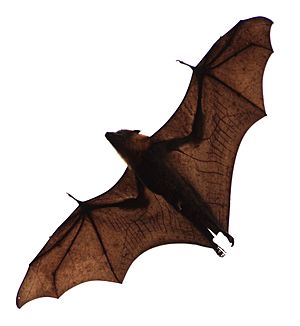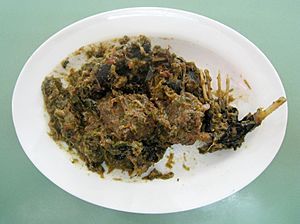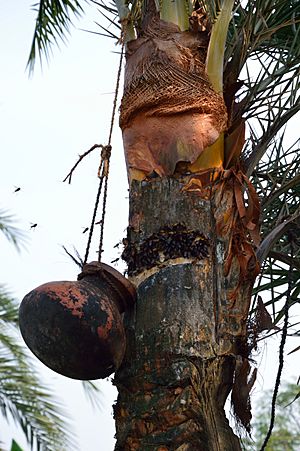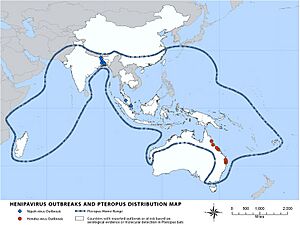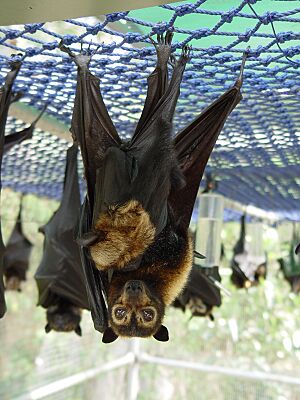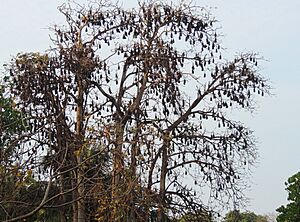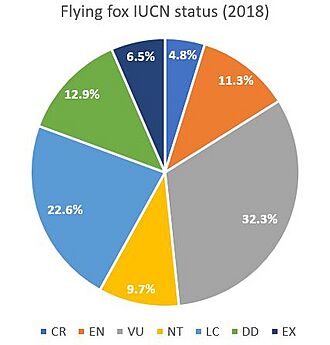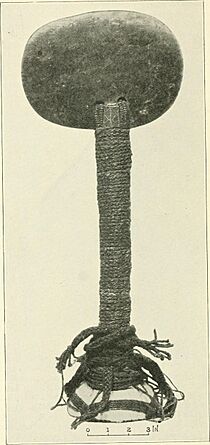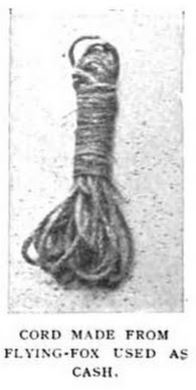Flying fox facts for kids
Quick facts for kids Flying fox |
|
|---|---|
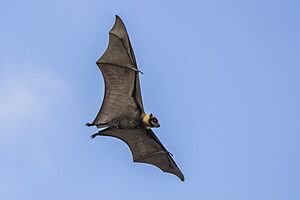 |
|
| Polynesian flying fox Pteropus tonganus, Taveuni, Fiji |
|
| Scientific classification |
|
| Kingdom: | Animalia |
| Phylum: | Chordata |
| Class: | Mammalia |
| Order: | Chiroptera |
| Family: | Pteropodidae |
| Genus: | Pteropus Brisson, 1762 |
| Type species | |
| Vespertilio vampyrus niger (= Pteropus niger) Kerr, 1792
|
|
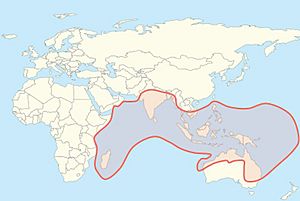 |
|
| Worldwide distribution of flying foxes | |
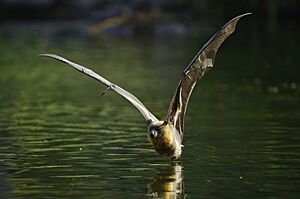
Pteropus is a group of large bats, often called fruit bats or flying foxes. They are some of the biggest bats in the world!
These amazing creatures live in parts of South Asia, Southeast Asia, Australia, East Africa, and many islands in the Indian and Pacific Oceans. There are at least 60 different kinds of flying foxes alive today. Sadly, six species of flying foxes have become extinct in recent times due to overhunting.
Most flying foxes are active at night, but some island species are active during the day, possibly because they have fewer predators.
Contents
- What Do Flying Foxes Look Like?
- Smart Bats: Flying Fox Intelligence
- Super Senses: Smell and Sight
- Flying Fox History: How They Evolved
- Reproduction
- Lifespan
- Living Together: Flying Fox Social Systems
- Diet
- Conservation Status
- Conservation efforts
- Why Flying Fox Populations Are Declining
- Flying Foxes as Pests
- Flying Foxes in Culture
- Importance
- Interesting facts about Flying Foxes
- See also
What Do Flying Foxes Look Like?
Flying foxes come in many sizes. Some weigh as little as 120 grams (about 4 ounces), while others can weigh up to 1.6 kilograms (about 3.5 pounds). Most flying foxes are smaller, weighing less than 600 grams (about 1.3 pounds). Males are usually bigger than females.
Their fur is long and soft, often with a patch of different colored fur on their head and shoulders, like a "mantle." They don't have tails. Their heads really do look like small foxes, with tiny ears and big eyes. Females have one pair of milk glands on their chest. Their ears are pointed and form a complete ring. All their toes have sharp, curved claws. Unlike smaller bats, flying foxes have a claw on both their thumb and index finger.

Smart Bats: Flying Fox Intelligence
Flying foxes have large brains for their body size, similar to domestic dogs! This means they are quite intelligent. They can remember places for a long time. Even though they travel thousands of kilometers each year, they always find their favorite feeding spots and roosts (places where they rest). They can also learn new things, like pulling a lever for juice, and remember how to do it years later.
Super Senses: Smell and Sight

Flying foxes rely a lot on their sense of smell. They use smell to find food, for mothers to find their babies, and for mates to find each other. Males have special glands on their shoulders that release scents to mark their territory, especially during mating season.
Flying foxes do not use echolocation (like sonar) to navigate. Instead, they depend on their excellent eyesight. Their eyes are quite large and face forward, giving them binocular vision (seeing with both eyes at once). They can see well in dim light, which helps them forage at night.
Flying Fox History: How They Evolved
Scientists don't have many fossils of flying foxes, which makes it hard to trace their exact history. However, by studying their DNA, scientists believe flying foxes started evolving millions of years ago.
Flying foxes likely first appeared in mainland Asia. From there, they spread out, colonizing islands in the Indian and Pacific Oceans. Today, you can find them in tropical and subtropical areas from the western Indian Ocean all the way to the Cook Islands in the Pacific.
Reproduction
Many flying fox species mate with several partners. However, the Samoa flying fox is an exception, as it usually mates with only one partner.
Most flying foxes have one litter of pups each year, usually in the spring. Females can stay fertile and have babies for at least 12 or 13 years.
A female flying fox is pregnant for about 140 to 190 days (4.6 to 6.3 months). She usually gives birth to one pup. Pups are born small and don't have much fur, so they depend completely on their mothers. They cling to their mother's belly, holding on with their thumb claws and teeth. Mothers carry their pups for the first few weeks. Later, they might leave the pups at the roost while they go find food at night.
Male flying foxes do not help raise the pups. Pups start to fly when they are about 3 months old, but they might not stop drinking their mother's milk until they are 4 to 6 months old. They can stay with their mothers until they are one year old.
Flying foxes become adults and can have their own babies when they are 1.5 to 2 years old.
Lifespan
Flying foxes live a long time for their size. In the wild, they often live for about 15 years. In zoos, they can live even longer, sometimes 20 to 28 years. The oldest known flying fox was an Indian flying fox named Statler, who lived to be 34 years old!
Living Together: Flying Fox Social Systems
Most flying fox species are social animals and live in large groups called colonies or "camps." These colonies can be huge! The large flying fox forms colonies of up to 15,000 individuals, and the little red flying fox can form colonies with as many as 100,000 bats. Some species, however, prefer to live alone.
The size of a colony can change throughout the year depending on what the bats need. For example, during breeding season, grey-headed flying foxes form groups with one male and several females. These groups break up after the breeding season.
Diet
Flying foxes mostly eat fruit, flowers, nectar, and leaves. Sometimes, they also munch on insects like cicadas. They find their food using their excellent sense of smell. Flying foxes often travel long distances to find food, sometimes flying 40–60 kilometers (25–37 miles) in one night.
When they find food, they hang upside down from a branch with their back feet. They use their clawed thumbs to pull branches closer to get fruits or flowers. When eating fruit, they squeeze the juice out with their tongue and then spit out the pulp.
They also eat many kinds of crops, which can cause problems with farmers. Some of the crops they enjoy include pineapple, breadfruit, mango, banana, avocado, and grapes.
Flying foxes eat a lot, consuming about 25–35% of their body weight every day!
For flying foxes in zoos, a good diet includes mostly hard fruits like pears and apples, with some soft fruits. Bananas should only be given sometimes because they are high in fiber, and flying foxes aren't used to a lot of fiber.
Conservation Status
As of 2018, out of 62 flying fox species, 3 are considered critically endangered, meaning they are at very high risk of becoming extinct. Another 7 species are endangered, and 20 are vulnerable. Sadly, 4 species are already extinct, including the Guam flying fox. More than half of all flying fox species are currently threatened with extinction. Many have disappeared from Pacific islands due to hunting, deforestation, and predators like invasive species.
Conservation efforts
All flying fox species are listed under CITES, an international agreement that controls the trade of wild animals. This helps prevent them from being traded illegally across borders. Some species have even stricter protections.
In Australia, some species like the grey-headed and spectacled flying foxes are protected as "vulnerable." In Japan, the Bonin flying fox and some types of Ryukyu flying fox have been designated as "Natural Monuments" since 1969. This means it's illegal to capture or disturb them without special permission. They are also listed as National Endangered Species, so they cannot be harmed or sold.
The United States also lists several flying fox species as threatened or endangered under its Endangered Species Act of 1973, even though these bats don't live in the continental U.S. This helps protect them globally.
To help endangered flying fox species, some are bred in zoos and sanctuaries. This is called captive breeding.
Why Flying Fox Populations Are Declining

Flying fox populations are shrinking or disappearing due to several reasons, both human-caused and natural. Because females usually have only one pup per year, their populations are very sensitive to threats. If too many bats die each year, their numbers will quickly decline.
Human Impacts on Flying Foxes
- Invasive Species: Animals like the brown tree snake can seriously harm flying fox populations, especially by eating many pups.
- Overhunting: While people have hunted flying foxes for food for a long time, growing human populations and better hunting tools have led to too many bats being killed. This has caused populations to shrink and even disappear in some areas.
- Culling and Nets: Farmers sometimes kill flying foxes by shooting, poisoning, or beating them to death to protect their crops. Bats also get accidentally caught and die in nets that farmers use to cover fruit trees.
- Electrocution: Flying foxes can be killed by flying into power lines. Some farmers also use electrified grids over their fruit trees to kill bats, though this method is not always effective at saving crops.
- Climate Change: Extreme heat waves in Australia have caused the deaths of tens of thousands of flying foxes. Rising sea levels also threaten species that live on low-lying islands.
Natural Threats to Flying Foxes
- Typhoons: Many flying fox species live on single islands, making them vulnerable to strong storms like typhoons. A typhoon in 1979 cut the population of the Rodrigues flying fox in half. Storms also destroy trees, making it harder for bats to find food and easier for hunters to spot them.
- Diseases: Diseases like tick paralysis can also cause flying fox deaths.
- Hunting: In some parts of the world, like Southeast Asia, South Asia, and Oceania, flying foxes are hunted for food.
Flying Foxes as Pests
Farmers sometimes see flying foxes as pests because they can damage fruit crops in orchards. They have been known to damage almonds, guavas, mangoes, lychees, and other fruits. However, sometimes damage caused by other animals is mistakenly blamed on flying foxes.
Flying fox colonies can also bother people living nearby. Their loud calls in the morning can disturb sleep. They can fly into power lines, causing electricity outages. Their droppings and body odor can also be unpleasant.
Flying Foxes in Culture

Flying foxes are important in many traditional cultures and stories. Historically, flying fox parts were used as currency. In New Caledonia, braided flying fox fur was once used as money. On Makira Island in the Solomon Islands, people still hunt flying foxes for their teeth, which are strung into necklaces and used as currency. The teeth of the insular flying fox are especially valued. Some experts believe that keeping this cultural value might encourage people to hunt bats in a sustainable way, rather than stopping the practice entirely.
Importance
Flying foxes are very helpful to nature. They help forests grow by spreading seeds from the fruits they eat. They also pollinate many plants, including the valuable durian fruit.
Interesting facts about Flying Foxes
- The scientific name Pteropus comes from ancient Greek words. 'Pterón' means "wing," and 'poús' means "foot." So, Pteropus literally means "wing-foot," which perfectly describes these flying mammals! The name was first used by a French zoologist named Mathurin Jacques Brisson in 1762.
- People have called these bats "flying foxes" since at least 1759. This name comes from their fox-like faces, with small ears and large eyes.
- The large flying fox has the longest wingspan of any bat, reaching up to 1.5 meters (about 5 feet) wide!
- Like other bats, flying foxes can carry certain viruses. These viruses are rarely passed to humans and usually only happen if a person is bitten or scratched by an infected bat.
- It's important to know that while other bat species have been linked to viruses like SARS and Ebola, flying foxes are not believed to be hosts for those specific viruses.
- Flying foxes also have special meaning in some cultures, appearing in art and stories. In the past, their fur and teeth were even used as money!
- They are sometimes used in traditional medicine. For example, some people believe that the fat of the Indian flying fox can treat rheumatism.
- In parts of India, tribes eat cooked flying fox meat to help with asthma and chest pain.
- In Bangladesh, some healers use flying fox hair to create treatments for fevers.
- Baby flying foxes are born with some "milk teeth," like human babies. As they grow, these milk teeth fall out and are replaced by permanent adult teeth. This usually happens by about 4.6 months old. Adult flying foxes have 34 teeth in total.
- They can fly at speeds of 6 meters per second (about 13.4 mph) for hours and reach top speeds of 8.6 meters per second (about 19 mph).
- Flying foxes have large hearts that beat very fast, from 100 to 400 times per minute when resting!
- Their digestive system is quite simple. Food can pass through their bodies in as little as 12 minutes. They don't have a cecum or an appendix.
See also
 In Spanish: Zorros voladores para niños
In Spanish: Zorros voladores para niños


